1/12/2024
In the hustle and bustle of modern life, our health often takes a back seat until one day our bodies send out urgent signals for help. One common health challenge we face is elevated cholesterol levels, a risk factor for cardiovascular diseases and a potential precursor to various health issues.
In the hustle and bustle of modern life, our health often takes a back seat until one day our bodies send out urgent signals for help. One common health challenge we face is elevated cholesterol levels, a risk factor for cardiovascular diseases and a potential precursor to various health issues.
When it comes to lowering cholesterol, visions of popping numerous pills or a radical overhaul of dietary habits might come to mind. However, here's a delightful and vibrant avenue you might not have considered: juices. Yes, it's not just about satisfying your taste buds but infusing your body with a vitality that works to lower cholesterol with every sip.
In this article, we'll delve into captivating juice recipes – not only to tantalize your taste buds but also to aid in bringing down those stubborn cholesterol levels,Juice Recipes for High Cholesterol. Get ready to uncover the magical powers of nature, kickstarting a new chapter of health through every liquid sunshine.

Read on to explore the enchanting world of juices, embarking on a delicious journey that rejuvenates your heart, body, and life.
In a world saturated with health advice, you might wonder: Why should I turn to juice recipes specifically to tackle high cholesterol? The answer lies in the nutritional powerhouse that fresh, homemade juices can be.
-
Packed with Plant Sterols: Juices crafted from fruits and vegetables often contain plant sterols, naturally occurring compounds that have been shown to block the absorption of cholesterol. These plant-based wonders act as a shield, helping to keep your cholesterol levels in check.
-
Rich in Antioxidants: The vibrant colors of fruits and vegetables in your juice aren't just visually appealing; they signify the presence of antioxidants. These compounds combat oxidative stress, reducing inflammation and preventing the oxidation of LDL cholesterol – a key player in the formation of artery-clogging plaques.
-
Abundant Fiber Content: Whole fruits and vegetables used in juicing retain their fiber content, a crucial element for cholesterol management. Fiber acts like a broom, sweeping away excess cholesterol and aiding in its elimination from the body.
-
Heart-Healthy Nutrients: Many ingredients found in cholesterol-lowering juice recipes boast heart-healthy nutrients such as potassium, magnesium, and omega-3 fatty acids. These elements contribute to overall cardiovascular well-being, complementing the effort to combat high cholesterol.
-
Hydration for Heart Health: Adequate hydration is paramount for cardiovascular health. Juices, with their high water content, contribute to hydration, promoting optimal blood flow and supporting the heart in its battle against elevated cholesterol levels.
So, if you're seeking a delicious and natural approach to manage your cholesterol, these juice recipes offer a convenient and enjoyable solution. Dive into the world of flavors while providing your body with the tools it needs to tackle high cholesterol – sip by sip.
In the next sections, we'll explore specific juice recipes, each carefully crafted to target and reduce cholesterol levels. Get ready to blend, pour, and savor your way to a healthier you.
13 Best Juice Recipes for High Cholesterol
-
Carrot Pineapple Orange Juice Recipe
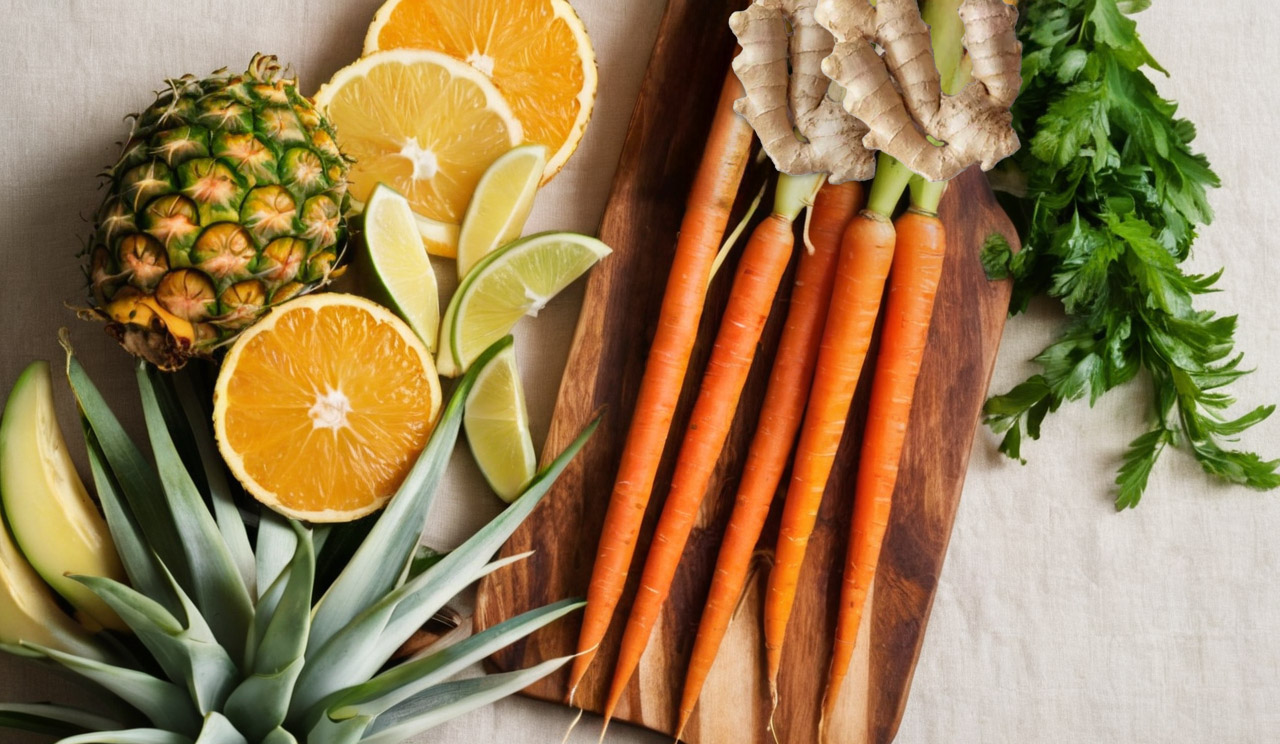
Carrot Pineapple Orange Juice is a delightful and nutrition-packed beverage that combines the benefits of various fruits. Here are some potential advantages:Why We Love This Carrot Pineapple Orange Juice Recipe
In the realm of refreshing beverages, our Carrot Pineapple Orange Juice stands out as a true elixir of vitality. Here are the reasons why we simply adore this delightful juice recipe:
Vibrant Burst of Flavor:
The combination of sweet carrots, tropical pineapple, and citrusy oranges creates a symphony of flavors that dance on your taste buds. It's a vibrant burst of freshness in every sip.Nutrient-Packed Goodness:
This juice is not just a treat for your palate; it's a nutrient powerhouse. Laden with vitamins, minerals, and antioxidants, each glass delivers a concentrated dose of healthful goodness.Elevated Energy Levels:
The natural sugars present in carrots, pineapples, and oranges provide a clean and sustainable energy boost. Say goodbye to artificial energy drinks and hello to a revitalizing, natural pick-me-up.Easy on the Eyes and the Body:
With the beta-carotene-rich carrots promoting eye health and the bromelain in pineapples supporting digestion, this juice is a visual and internal delight. It's beauty and wellness in a glass.Versatile and Adaptable:
This recipe serves as a versatile canvas for customization. Add a hint of ginger for warmth, a handful of spinach for an extra nutrient kick, or a splash of mint for a refreshing twist. The possibilities are as endless as your imagination.Heart-Healthy Indulgence:
Beyond the tantalizing taste, the ingredients in this juice contribute to cardiovascular well-being. Potassium, fiber, and antioxidants work in harmony to love your heart back.Quick and Easy to Make:
In the rush of daily life, convenience matters. This recipe is a breeze to whip up, making it a practical choice for those who want a health boost without sacrificing time.
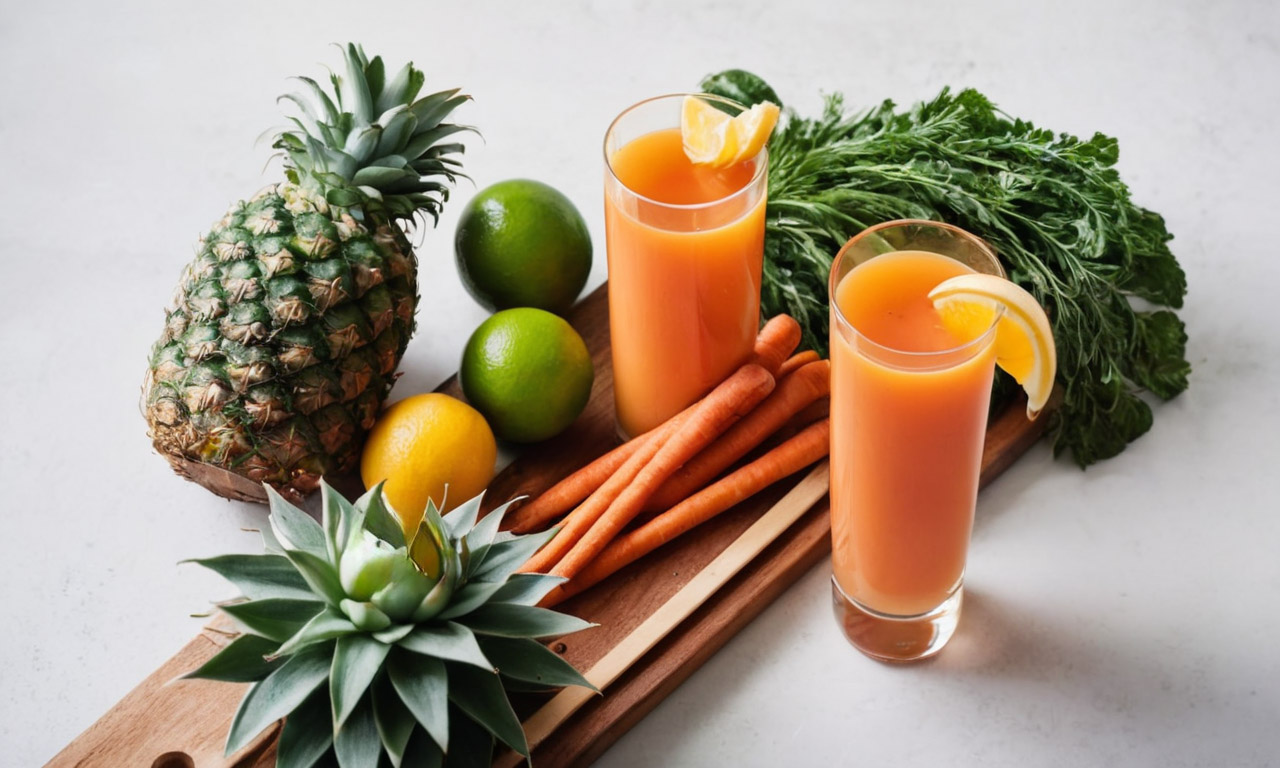
How to Pick a Ripe Pineapple
Selecting a ripe pineapple is essential to ensure that you enjoy its sweet and juicy flavor. Here are some tips on how to pick a ripe pineapple:
Color:
Look for a pineapple with a vibrant golden color. While the intensity of the color may vary based on the pineapple variety, avoid greenish or completely yellow pineapples, as they may not be fully ripe.Smell:
Give the base of the pineapple a gentle sniff. A ripe pineapple should have a sweet and fragrant aroma at the stem end. If it smells sweet, it's a good indicator that the fruit is ready to eat.Texture:
The skin of a ripe pineapple should have a slight give when pressed, indicating that the fruit is soft and juicy inside. However, avoid pineapples with soft spots or areas that feel mushy, as these may be overripe or starting to rot.Weight:
Hold the pineapple in your hands and feel its weight. A ripe pineapple should feel heavy for its size, suggesting that it is filled with juice. If it feels too light, it may be underripe.Leaf Appearance:
While the appearance of the leaves isn't the most reliable indicator, you can check them for freshness. The leaves at the top should be green and healthy-looking. If they're brown or wilted, it may indicate an overripe pineapple.Uniform Shape:
Choose a pineapple with a uniform shape. Irregularities, such as bumps or flat sides, could be a sign of uneven ripening.Ripe Top:
Check the crown (the leafy top) of the pineapple. If it pulls out easily, the pineapple is likely ripe. However, this method is less reliable than the other indicators.Remember that pineapples do not ripen further after harvest, so it's important to select one that is already ripe for immediate consumption. If you don't plan to eat the pineapple right away, you can store it in the refrigerator for a few days to maintain its freshness.
Ingredients
orange (peeled)
5.8 oz
164 g
1 1/4 medium oranges
carrot
6.25 oz
177 g
3 medium carrots
pineapple
8.4 oz
238 g
1/5 pineapple (1 1/2 cups pineapple chunks)
lime
0.8 oz
23 g
1/2 lime
ginger
0.25 oz
7 g
1 inch chunk ginger root
Instructions:
Pro Tips:
-
Have fun with garnishes! A pineapple slice, an orange twist, or a sprig of mint can add visual appeal and an extra layer of flavor to your beverage.
-
Enhance the refreshing nature of the juice by using ice cubes made from additional pineapple or orange juice. This prevents dilution and adds more flavor.
-
Consume the juice immediately for the freshest taste. If you need to store it, keep it in an airtight container in the refrigerator for up to 24 hours. Shake or stir before serving.
-
After juicing, clean your juicer immediately. It's much easier to clean when the remnants haven't dried and hardened.
-
Elevate the freshness by adding a few fresh mint leaves to the juicer. Mint complements the fruity and zesty flavors, providing a delightful aromatic note.
-
Achieve a perfect balance of sweetness and tanginess by tasting the juice as you go. If it's too sweet, add a bit more lime juice; if it's too tart, consider adding a touch of honey or agave syrup.
-
If you enjoy a pulp-free juice, strain the mixture after juicing. Alternatively, embrace the fiber and nutrients by keeping the pulp.
-
Serve the juice chilled for a more enjoyable drinking experience. You can refrigerate the ingredients before juicing or add ice cubes to the finished product.
-
Adjust the ratios of ingredients to suit your taste preferences. If you prefer a sweeter juice, add more pineapple or orange. For a zesty kick, increase the amount of lime or ginger.
-
For a refreshing beverage, consider pre-chilling the pineapple, oranges, and carrots before juicing. This adds a coolness to your drink, especially if you're not using ice.
-
Use fresh, high-quality produce to maximize the nutritional content and overall taste of your juice.
-
Choose ripe and sweet pineapples, oranges, and carrots for the best flavor. A ripe pineapple will have a sweet aroma, while oranges should be vibrant and heavy for their size.
-
Give the juice a gentle stir and sip slowly, savoring the burst of tropical and citrus flavors with each delightful gulp.
-
Garnish with a slice of pineapple or a twist of orange for a decorative and citrusy touch.
-
Pour the freshly made Carrot Pineapple Orange Juice into glasses.
-
Consider adding ice cubes for a refreshing touch, especially if serving on a warm day.
-
If you prefer a smoother juice, you can strain the mixture using a fine-mesh sieve or cheesecloth to remove pulp. However, keeping the pulp can add extra fiber to your drink.
-
Turn on the juicer and let it process all the ingredients. Make sure to extract as much juice as possible.
-
Add the chopped ginger to the juicer. Ginger contributes a subtle spiciness and warmth to the juice, creating a harmonious blend of flavors.
-
Squeeze the juice of one lime into the mix. The lime adds a zesty kick that enhances the overall flavor profile.
-
Follow with the chopped carrots. Carrots add a vibrant color and earthy sweetness to the juice, balancing the flavors.
-
Add the peeled orange segments to the juicer. The natural sweetness of the oranges will complement the tanginess of the pineapple.
-
Set up your juicer according to the manufacturer's instructions.
-
Begin by adding the pineapple chunks to the juicer chute. Allow the juicer to extract the pineapple juice.
-
Peel and chop the pineapple into chunks.
-
Peel the oranges and separate them into segments.
-
Wash and chop the carrots into smaller pieces.
-
Peel and chop the ginger into small pieces.
-
Select Ripe Ingredients:
-
Freshness Matters:
-
Pre-Chill Ingredients:
-
Experiment with Ratios:
-
Keep it Cold:
-
Mind the Pulp:
-
Balance Sweetness and Tanginess:
-
Add a Minty Twist:
-
Clean Your Juicer Promptly:
-
Storage Tips:
-
Boost with Ice:
-
Experiment with Garnishes:
-
Prepare the Ingredients:
-
Juicing:
-
Add Oranges:
-
Incorporate Carrots:
-
Lime Zest:
-
Introduce Ginger:
-
Juice It Up:
-
Strain (Optional):
-
Serve and Enjoy:
-
Garnish (Optional):
-
Stir and Sip:
-
Rich in Antioxidants: Carrots, pineapples, and oranges are abundant in antioxidants such as vitamin C and carotenoids. These antioxidants help neutralize free radicals, reduce oxidative stress, and contribute to overall cell health.
-
Promotes Digestive Health: The fiber in carrots aids in digestion by slowing down the passage of food through the digestive tract, helping control blood sugar levels, and lowering cholesterol.
-
Vision Support: Carrots, with their high beta-carotene content, are essential for maintaining healthy vision. This may be beneficial in slowing the progression of age-related macular degeneration and other eye conditions.
-
Immune System Boost: Vitamin C, abundant in orange juice and pineapples, is crucial for enhancing the immune system. This aids in warding off colds and other illnesses.
-
Cardiovascular Health: Bromelain in pineapples and potassium in oranges contribute to cardiovascular health. Additionally, the fiber and plant compounds in oranges may help lower cholesterol levels.
-
Anti-Inflammatory Properties: Enzymes in pineapple and antioxidants in oranges possess anti-inflammatory properties, assisting in reducing inflammation in the body.
-
Berry Explosion Juice Recipe
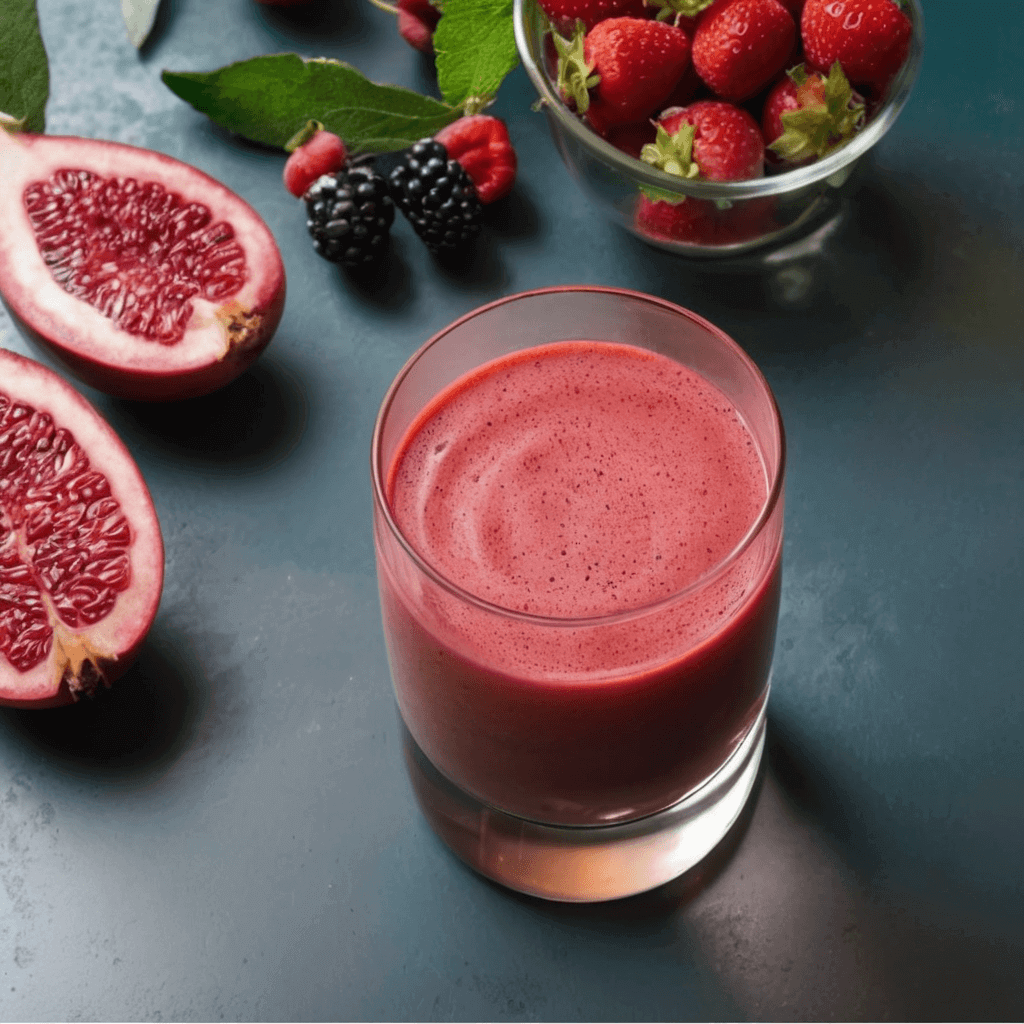 "Berry Explosion Juice" is a delightful concoction that blends various berries, including strawberries, blueberries, and raspberries. This mixed berry juice may bring about several health benefits. Here are some potential advantages:
"Berry Explosion Juice" is a delightful concoction that blends various berries, including strawberries, blueberries, and raspberries. This mixed berry juice may bring about several health benefits. Here are some potential advantages:
Ingredients
-----------
strawberries
1.33 oz
38 g
3 1/2 strawberries
blackberries
0.66 oz
19 g
3 blackberries
raspberries
0.5 oz
14 g
3 1/2 raspberries
blueberries
0.66 oz
19 g
7 blueberries
pomegranate arils
2 oz
57 g
2/3 cup arils
watermelon
12.4 oz
352 g
2 cups cubed watermelon
fresh mint
0.15 oz
4 g
4 mint leaves or 2 1/2 tablespoons chopped mint
**instructions:**

**Pro Tips:**
-
If you have leftover juice, store it in an airtight container in the refrigerator. Shake well before serving to recombine any settled pulp.
-
After juicing, clean your juicer immediately to prevent staining and make the cleaning process easier.
-
Pour the juice slowly over ice for a layered effect, showcasing the vibrant colors of the berries.
-
Chill your serving glasses in the freezer before pouring the juice. This maintains the cold temperature of the beverage.
-
Consider adding a splash of citrus, like lime or lemon juice, for a tangy twist that complements the sweetness of the berries.
-
Adjust the quantities of each berry to find your preferred flavor balance. Some might enjoy a more dominant blueberry flavor, while others prefer a medley of all berries.
-
Experiment with garnishes. A few floating berries, a slice of watermelon, or additional mint leaves can enhance the visual appeal of your drink.
-
Consider leaving some or all of the pulp in your juice. The fiber content in pulp adds to the nutritional value of your beverage.
-
Mint can be powerful, so start with a few leaves and add more if desired. It's best to infuse a subtle minty note rather than overpowering the berry flavors.
-
Taste the juice as you go and adjust sweetness if needed. If your berries are particularly sweet, you might not need to add extra sweeteners.
-
Pomegranate arils can be a bit tricky. To extract more juice, gently press them with a spoon before adding to the juicer.
-
When loading ingredients into the juicer, layer them strategically. Place softer fruits like berries closer to the juicing mechanism to optimize extraction.
-
For an extra refreshing beverage, refrigerate the berries and watermelon before juicing. This helps maintain the chilled temperature of the juice.
-
Opt for fresh and ripe berries to ensure maximum flavor and nutritional content. Look for plump, vibrant fruits without signs of overripeness.
-
Take a moment to savor the vibrant colors and diverse flavors of your homemade Berry Explosion Juice. Sip slowly and let the explosion of berries dance on your taste buds.
-
Garnish each glass with a fresh mint sprig for a burst of color and an extra hint of minty goodness.
-
Pour the Berry Explosion Juice into glasses over ice cubes for a chilled and refreshing experience.
-
For a smoother texture, strain the juice using a fine-mesh sieve or cheesecloth to remove any remaining pulp. However, leaving the pulp in adds extra fiber.
-
If you prefer a homogenous juice, stir the extracted juice well to blend the flavors.
-
Drop a few fresh mint leaves into the juicer. The mint will infuse a subtle, aromatic flavor into the juice.
-
Turn on the juicer and let it process all the berries and watermelon, extracting their delicious juices.
-
Introduce the diced watermelon to the juicer. Watermelon adds a refreshing and hydrating element to the juice.
-
Add the vibrant pomegranate arils to the juicer. These little bursts of sweetness will enhance the overall berry explosion.
-
Follow with strawberries, raspberries, and blueberries, letting each contribute its unique flavor to the mix.
-
Set up your juicer according to the manufacturer's instructions.
-
Begin by adding the blackberries to the juicer chute. Allow the juicer to extract the rich blackberry juice.
-
Pick a handful of fresh mint leaves and gently bruise them to release their flavor. Set aside for later garnish.
-
Wash all the berries thoroughly.
-
Hull the strawberries and remove the stems from any other berries if needed.
-
Dice the watermelon into small cubes.
-
Choose Fresh, Ripe Berries:
-
Pre-Chill Ingredients:
-
Layering for Optimal Extraction:
-
Mind the Pomegranate:
-
Control Sweetness:
-
Play with Mint Quantity:
-
Keep Pulp for Fiber:
-
Creative Garnishing:
-
Experiment with Ratios:
-
Variation with Citrus:
-
Serve in Chilled Glasses:
-
Presentation Matters:
-
Clean Your Juicer Promptly:
-
Store Properly:
-
Prepare the Ingredients:
-
Minty Fresh Start:
-
Juicing Time:
-
Berry Mix-In:
-
Pomegranate Boost:
-
Watermelon Refreshment:
-
Juice Extraction:
-
Minty Infusion:
-
Mix it Up:
-
Strain (Optional):
-
Serve Chilled:
-
Garnish with Mint:
-
Sip and Enjoy:
-
Antioxidant Power: Berries are rich in antioxidants such as vitamin C, flavonoids, and polyphenols. These antioxidants help neutralize free radicals, reduce oxidative stress, and contribute to disease prevention while maintaining cellular health.
-
Cardiovascular Health: The antioxidants and fiber in berries contribute to lowering the risk of cardiovascular diseases. They aid in reducing blood pressure, improving cholesterol levels, and enhancing overall heart health.
-
Immune System Support: Berries are an excellent source of vitamin C, boosting the immune system and increasing resistance against colds and other illnesses.
-
Anti-Inflammatory Effects: Compounds found in berries exhibit anti-inflammatory properties, assisting in reducing inflammation in the body. This could be beneficial for inflammatory conditions.
-
Improved Digestion: The dietary fiber in berries promotes a healthy digestive system, preventing constipation and supporting a well-balanced gut microbiome.
-
Energy Boost: Natural sugars present in berries provide a quick and sustainable energy boost, making it a healthy snack or beverage choice.
-
Skin Health Maintenance: Antioxidants in berries help protect the skin from free radical damage, supporting overall skin health and a youthful appearance.
-
Cognitive Function Enhancement: Some studies suggest that natural compounds in berries may contribute to improved cognitive function and help prevent neurodegenerative diseases.
-
Homemade V8 Juice Recipe
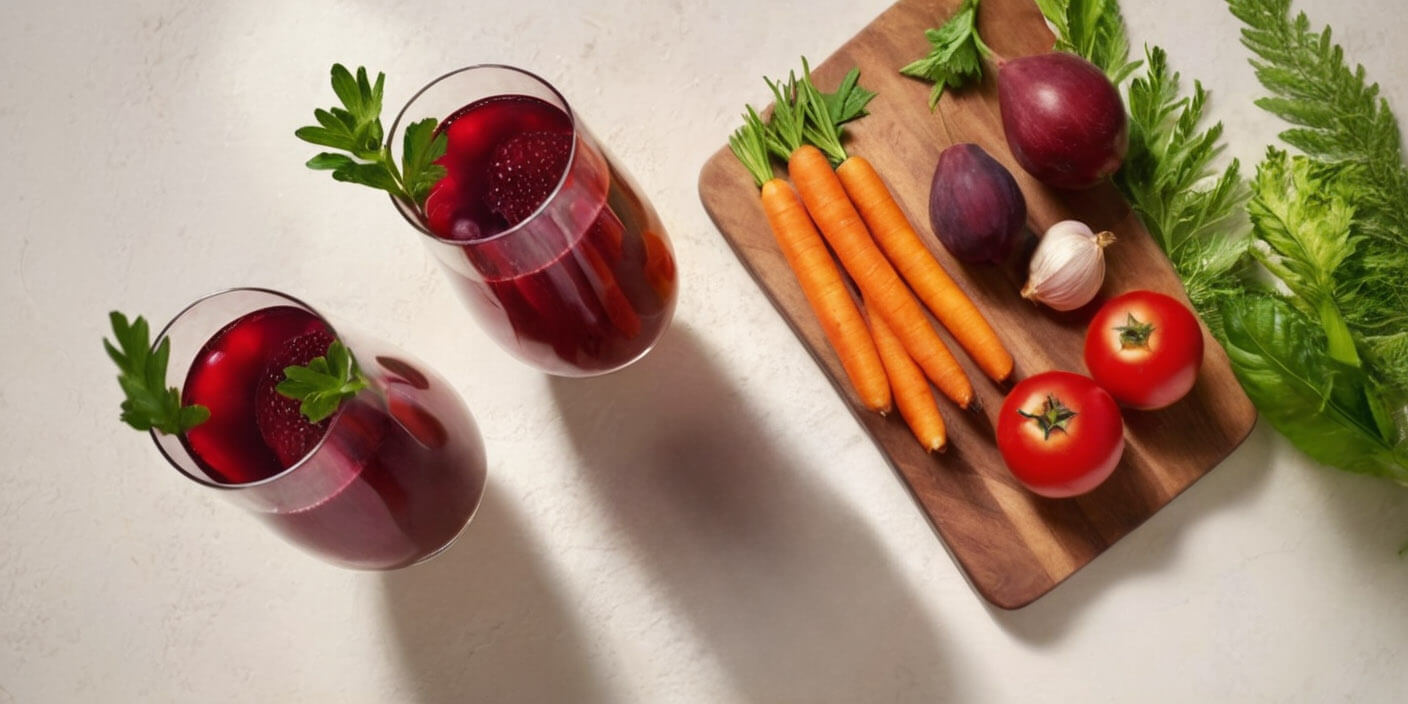 The typical recipe for V8 Vegetable Juice includes the following vegetables:
The typical recipe for V8 Vegetable Juice includes the following vegetables:
These vegetables are blended and processed, resulting in a juice rich in vitamins, minerals, and antioxidants. As a vegetable-centric drink, V8 Vegetable Juice is considered a nutritious beverage that provides various essential nutrients for the body.
Here are some of the potential advantages of V8 Juice:
Ingredients
-----------
romaine
0.71 oz
20 g
1/2 cup shredded
spinach
0.63 oz
18 g
1/2 cup
parsley
0.36 oz
10 g
1/4 cup chopped
tomato
11.46 oz
325 g
2 tomatoes
carrot
3.22 oz
91 g
1 1/2 medium carrots
celery
1.21 oz
34 g
1 medium stalk
watercress
0.14 oz
4 g
1/5 cup chopped
beet (red variety)
0.11 oz
3 g
1 slice (1" diameter)
garlic
0.08 oz
2 g
1/2 clove
**Instructions:**
-
After juicing, clean your juicer immediately to prevent staining and make the cleaning process easier.
-
If you have leftover juice, store it in an airtight container in the refrigerator. Shake or stir before serving to recombine any settled pulp.
-
Ensure your glasses are chilled before serving to maintain the freshness and coolness of the juice.
-
If your juice is too thick, thin it out with a small amount of water until you achieve your desired consistency.
-
Experiment with adding fresh herbs like basil or cilantro for an extra layer of flavor. These herbs can elevate the taste of your V8 Juice.
-
Enhance the flavor profile by adding a splash of fresh lemon or lime juice. Citrus adds brightness and complements the earthy notes of the vegetables.
-
Straining is optional and depends on your preference for pulp. Strain if you want a smoother juice, or leave the pulp for added fiber and texture.
-
Adjust the quantities of each vegetable to find the flavor balance that suits your palate. Some may prefer a more tomato-forward juice, while others enjoy a variety of flavors.
-
Adjust the amount of garlic to your taste preference. If you're new to adding garlic to your juice, start with a smaller quantity and increase gradually.
-
If your juicer has a pulse function, use it when juicing leafy greens. This can help extract more juice from these delicate ingredients.
-
Layer denser vegetables like tomatoes and carrots with lighter ones like celery and watercress to ensure an even juicing process.
-
When loading the vegetables into the juicer, start with the leafy greens like romaine, spinach, and watercress. This helps optimize the extraction process.
-
For a more refreshing juice, consider refrigerating the vegetables before juicing or adding ice cubes to the finished product.
-
Use fresh, high-quality vegetables for the best flavor and nutritional content. Farmer's markets or local produce stands are great places to find fresh ingredients.
-
Take a moment to savor the fresh, homemade V8 Juice. Sip slowly and appreciate the nutritious goodness of this vegetable-packed beverage.
-
Garnish with a celery stick, a slice of tomato, or a sprig of parsley for a decorative touch.
-
Refrigerate the V8 Juice for a few hours before serving, or pour it over ice cubes for an immediate refreshment.
-
If the juice is too thick, you can add a small amount of water and stir until you achieve the desired consistency.
-
For a smoother juice, strain the mixture using a fine-mesh sieve or cheesecloth to remove any remaining pulp. However, leaving some pulp can add extra fiber to your drink.
-
Once all the vegetables are juiced, carefully pour the vibrant V8 Juice into a glass container.
-
If your juicer has a pulse function, use it for the leafy greens to ensure efficient extraction.
-
Set up your juicer according to the manufacturer's instructions.
-
Turn on the juicer and begin feeding the vegetables into the chute. Allow the machine to extract the juice, collecting it in a pitcher or bowl.
-
Layer the vegetables strategically in the juicer. Start with the leafy greens like romaine, spinach, and watercress, followed by denser vegetables like tomatoes, carrots, celery, and beet. Add minced garlic last.
-
Wash all vegetables thoroughly.
-
Chop the romaine lettuce, spinach, parsley, tomatoes, carrot, celery, watercress, beet, and garlic into smaller pieces for easier juicing.
-
V8 Juice provides a convenient and delicious way to incorporate vegetables into the diet, contributing to dietary diversity and ensuring the body receives a range of essential nutrients.
-
Specific versions of V8 Juice offer a nutritious option with relatively lower calories, making it suitable for those seeking a lower-calorie beverage.
-
Some components in vegetables have anti-inflammatory properties, aiding in reducing inflammation in the body and potentially assisting with inflammatory conditions.
-
Nutrients like potassium in vegetables, including tomatoes in V8 Juice, may contribute to cardiovascular health by helping lower high blood pressure and improve cholesterol levels.
-
V8 Juice contains dietary fiber from vegetables, promoting a healthy digestive system, preventing constipation, and supporting a balanced gut microbiome.
-
Rich in a variety of vegetables, V8 Juice supplies ample antioxidants that help neutralize free radicals, reduce oxidative stress, and potentially prevent chronic diseases.
-
The combination of vegetables in V8 Juice provides various vitamins (such as vitamin A, vitamin C) and minerals (such as potassium, magnesium, and folate), supporting normal physiological functions in the body.
-
Freshness is Key:
-
Pre-Chill Ingredients:
-
Leafy Greens First:
-
Alternate Dense and Light Vegetables:
-
Pulse Leafy Greens:
-
Mind the Garlic:
-
Experiment with Ratios:
-
Strain According to Preference:
-
Add a Citrus Twist:
-
Customize with Herbs:
-
Adjust Thickness with Water:
-
Serve in Chilled Glasses:
-
Store Properly:
-
Clean Your Juicer Promptly:
-
Prepare the Ingredients:
-
Layering in the Juicer:
-
Juicing Process:
-
Pulse Leafy Greens:
-
Collect the Juice:
-
Strain (Optional):
-
Adjust Consistency (Optional):
-
Serve Chilled:
-
Garnish (Optional):
-
Sip and Enjoy:
-
Vitamins and Minerals Supply:
-
Antioxidant Action:
-
Dietary Fiber Content:
-
Cardiovascular Health:
-
Anti-Inflammatory Properties:
-
Low-Calorie Option:
-
Dietary Diversity:
-
Tomatoes
-
Carrots
-
Green Bell Peppers
-
Celery
-
Broccoli
-
Spinach
-
Beets
-
Parsley
-
ABC Juice (Apple, Beet, Carrot) Recipe
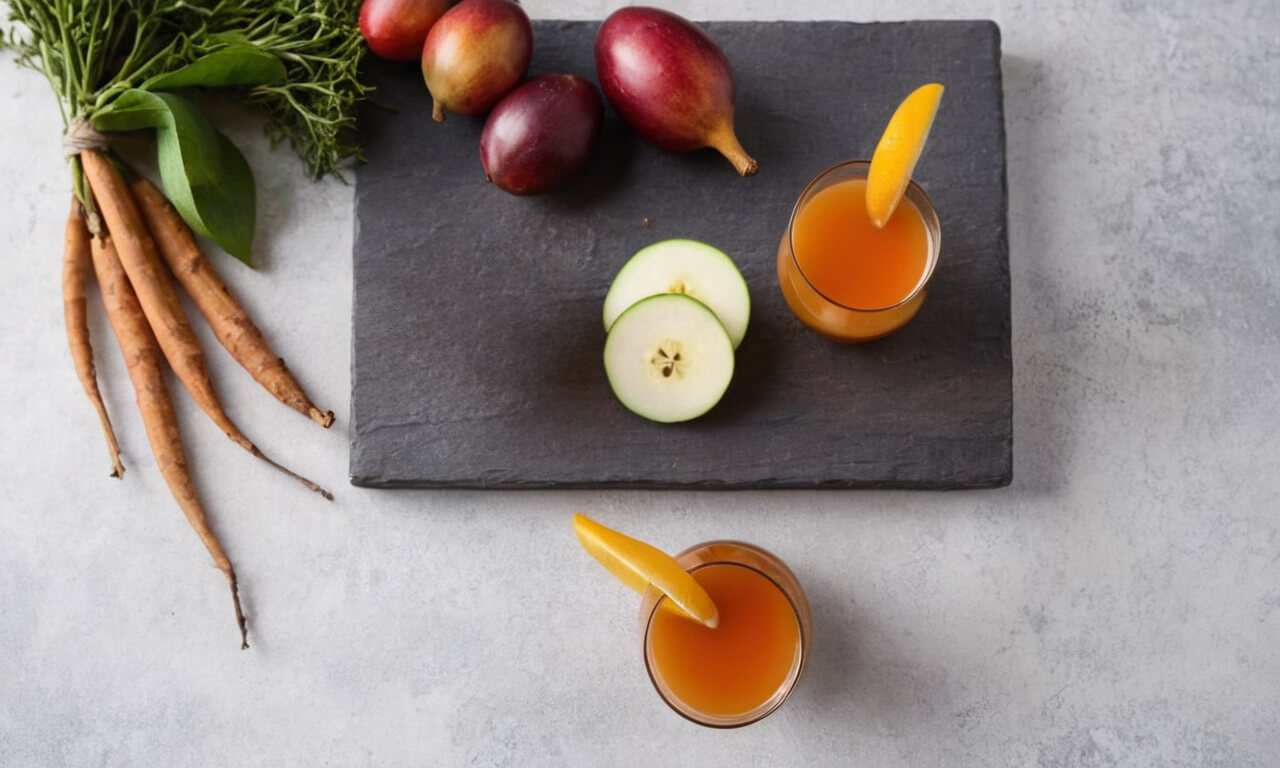 ABC Juice is a refreshing fruit and vegetable juice that combines the goodness of Apple, Beet, and Carrot. The acronym "ABC" represents the three main ingredients, each contributing its own set of health benefits. This popular juice is celebrated for its delicious taste and potential nutritional advantages.Here's a breakdown of the potential benefits from the primary components of ABC Juice:
ABC Juice is a refreshing fruit and vegetable juice that combines the goodness of Apple, Beet, and Carrot. The acronym "ABC" represents the three main ingredients, each contributing its own set of health benefits. This popular juice is celebrated for its delicious taste and potential nutritional advantages.Here's a breakdown of the potential benefits from the primary components of ABC Juice:
Ingredients
-----------
green apple
8 oz
227 g
1 1/5 medium apples
gold beet
1.75 oz
50 g
1/3 beet
carrot
14 oz
397 g
6 1/2 medium carrots
lemon (optional)
0.65 oz
18 g
1/6 medium lemon
**Instructions:**
-
After juicing, clean your juicer immediately to prevent staining and maintain optimal performance.
-
Adjust the ratio of ingredients based on your nutritional goals. For example, increase the carrot content for extra beta-carotene.
-
Consume the juice fresh for the best taste and nutritional benefits. If storing, keep it in an airtight container in the refrigerator and shake well before serving.
-
Elevate the flavor profile by adding fresh herbs like mint or basil. Herbs can provide a delightful aromatic touch to your ABC Juice.
-
If additional sweetness is desired, consider adding a small amount of honey or agave nectar rather than refined sugars.
-
Chill the ingredients before juicing and serve the juice over ice for a refreshing experience, especially during warmer days.
-
Strain the juice if you prefer a smoother texture, but leaving some pulp can enhance the fiber content. Decide based on your personal preference.
-
If your juicer has a pulse function, use it to achieve a more homogeneous juice. Alternatively, stir the juice well.
-
Consider juicing in the order of denser ingredients first (carrots and beets) followed by lighter ones (apples). This helps optimize the extraction process.
-
Adding a splash of fresh lemon juice enhances the overall flavor with a citrusy zing. Start with a little and adjust according to your taste.
-
Depending on your preference, you can leave the peel on the apples and beet for added fiber or peel them for a smoother texture.
-
Adjust the ratio of carrots, apples, and beets to find the flavor balance that suits your taste preferences. Experimenting with quantities can create a juice tailored to your liking.
-
Consider using organic produce, especially for ingredients like apples and carrots, to minimize pesticide exposure.
-
Opt for fresh, high-quality carrots, green apples, and gold beets to maximize flavor and nutritional content.
-
Take a moment to savor the crisp and flavorful ABC Juice. Sip slowly and revel in the nutritious goodness of this vibrant blend.
-
Garnish with a slice of green apple or a twist of lemon on the rim of the glass for a decorative touch.
-
Refrigerate the ABC Juice for a few hours before serving or pour it over ice cubes for an instant cooling effect.
-
Taste the juice and adjust the flavors as needed. If it's too thick, you can dilute it with a bit of water. If it needs sweetness, consider adding a touch of honey.
-
If you prefer a smoother texture, strain the juice using a fine-mesh sieve or cheesecloth to remove any remaining pulp. However, leaving some pulp adds extra fiber.
-
If your juicer has a pulse function or if you prefer a more homogeneous juice, you can pulse the ingredients again or stir the juice manually.
-
Turn on the juicer and let it process the ingredients, extracting the vibrant juice.
-
For a citrusy twist, squeeze fresh lemon juice into the juicer. Adjust the quantity based on your preference for tartness.
-
Follow with the chopped gold beet. Beets contribute a sweet and earthy flavor to the juice.
-
Add the chopped green apples to the juicer. The crispness of green apples adds a refreshing taste to the juice.
-
Begin by adding the carrots to the juicer chute. Carrots are dense and will yield a substantial amount of juice.
-
Set up your juicer according to the manufacturer's instructions.
-
Wash and peel the carrots. Chop them into smaller pieces.
-
Core the green apples and chop them into chunks.
-
Peel and chop the gold beet into manageable pieces.
-
Abundant in beta-carotene (a precursor to vitamin A), supporting vision and skin health.
-
Offers natural sweetness while being a low-calorie nutritional powerhouse.
-
Contains natural nitrates, which can be converted to nitric oxide, aiding in vasodilation and potentially lowering blood pressure.
-
Rich in antioxidants, helping to alleviate oxidative stress.
-
Provides natural sweetness along with a rich source of vitamin C and dietary fiber.
-
Supports immune system function and contributes to cardiovascular health.
-
Choose Fresh Produce:
-
Organic Option:
-
Balance the Flavors:
-
Peeled or Unpeeled:
-
Citrus Zing:
-
Juicing Order:
-
Pulse for Homogeneity:
-
Straining Decisions:
-
Temperature Control:
-
Sweeten Naturally:
-
Experiment with Herbs:
-
Storage Tips:
-
Customize the Ratio:
-
Clean Your Juicer Promptly:
-
Prepare the Ingredients:
-
Juicer Setup:
-
Layering in the Juicer:
-
Follow with Green Apples:
-
Introduce Gold Beet:
-
Optional Lemon Juice:
-
Juicing Process:
-
Pulse or Stir (Optional):
-
Strain (Optional):
-
Adjust Flavors:
-
Serve Chilled:
-
Garnish (Optional):
-
Sip and Enjoy:
-
Apple:
-
Beet:
-
Carrot:
Spinach-Apple Green Juice Recipe
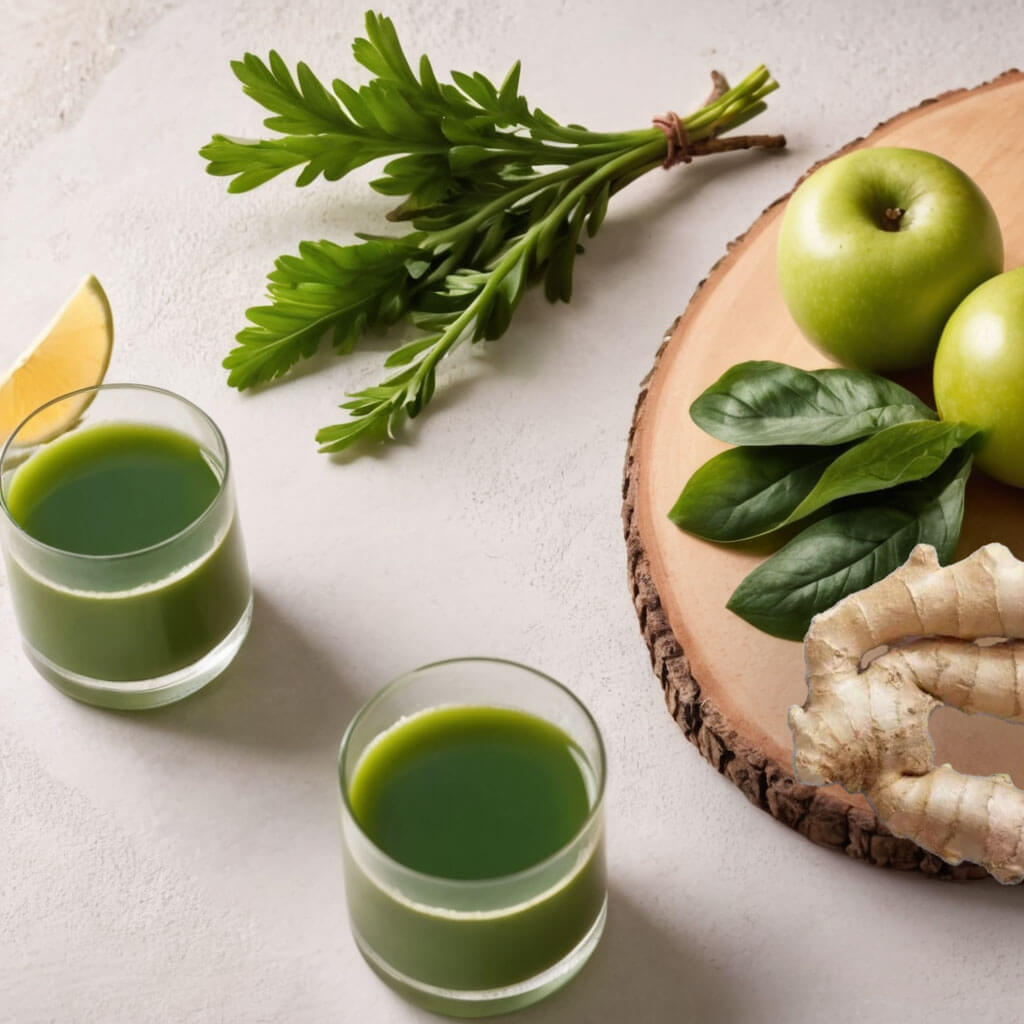
Spinach-Apple Green Juice is a nutritious beverage that combines the earthy taste of spinach with the sweet, crisp flavor of apples. Here's some potential benefits:
Ingredients
-----------
ginger
0.5 oz
14 g
6 slices (1 inch diameter)
green apple
4 oz
113 g
2/3 medium apple
celery
1.6 oz
45 g
1 medium stalk
parsley
1.7 oz
48 g
2/3 cups of chopped parsley
spinach
4.6 oz
130 g
4 1/2 cups of spinach
lemon
0.4 oz
11 g
1/5 medium lemon
romaine
4.5 oz
128 g
3 cups of chopped romaine
**Instructions:**
**Pro Tips:**
-
Experiment with Ratios: Adjust the quantities of ingredients based on your taste preferences.
-
Temperature Control: Chill the ingredients before juicing for a more refreshing drink.
-
Citrus Zest: Add a bit of lemon zest for an extra burst of citrus flavor.
-
Customize with Herbs: Experiment with adding fresh mint or cilantro for added freshness.
-
Before serving, stir the juice well to mix any settled pulp. Sip and enjoy the vibrant and nutrient-packed Spinach-Apple Green Juice.
-
Garnish the glasses with a slice of apple or a sprig of parsley for a decorative touch.
-
Refrigerate the green juice for a few hours before serving or pour it over ice cubes for an immediate refreshing experience.
-
Strain the juice using a fine-mesh sieve or cheesecloth if you want a smoother, pulp-free juice.
-
If you prefer a smoother texture, blend the juice using a blender after juicing.
-
Depending on your preference, you can adjust the ratio of apples to spinach or add more lemon for a tangy flavor.
-
Turn on the juicer and start the juicing process. Ensure all ingredients are fed evenly into the juicer.
-
Begin by adding spinach leaves to the juicer, followed by celery, ginger, green apples, lemon segments, parsley, and romaine lettuce.
-
Wash the fresh spinach leaves, celery, parsley, and romaine lettuce thoroughly.
-
Core and chop the green apples.
-
Peel and chop the ginger.
-
Peel and segment the lemon.
-
Spinach-Apple Green Juice is typically low in calories, suitable for those focusing on a health-conscious diet.
-
Apples offer a natural source of energy, making it a healthy energy-boosting beverage.
-
The dietary fiber in apples contributes to promoting a healthy digestive system.
-
Both spinach and apples contain antioxidants, helping neutralize free radicals and slow down oxidative processes.
-
Spinach provides vitamins A, C, K, and minerals like iron and calcium, while apples are rich in vitamin C and dietary fiber.
-
Prepare the Ingredients:
-
Layering in the Juicer:
-
Juicing Process:
-
Adjust Consistency:
-
Optional Blending (for Smoothness):
-
Strain (Optional):
-
Chill and Serve:
-
Garnish (Optional):
-
Stir and Enjoy:
-
Rich in Vitamins and Minerals:
-
Antioxidant Power:
-
Promotes Digestive Health:
-
Natural Energy Boost:
-
Low in Calories:
-
Green tea
Benefits of Green Tea:**
Researchers in a [2020 study](https://www.ncbi.nlm.nih.gov/pmc/articles/PMC7216725/)
According to research in a [2021 review](https://www.ncbi.nlm.nih.gov/pmc/articles/PMC8366653/)
black tea may also have positive effects on cholesterol.
-
The antioxidants in green tea may help reduce the growth of oral bacteria, contributing to better oral health and reducing the risk of bad breath and cavities.
-
Laboratory studies and epidemiological research hint at the potential of green tea antioxidants in inhibiting the growth of cancer cells. However, related research is ongoing.
-
Some studies suggest that green tea may help improve blood sugar control, offering benefits for the prevention or management of diabetes.
-
Components in green tea are thought to possess anti-inflammatory properties, potentially providing protection against inflammatory diseases.
-
Catechins in green tea are believed to have a metabolism-boosting effect, aiding in weight management.
-
The catechins in green tea are associated with improved cognitive function and increased brain activity. Some research indicates a potential role in slowing the progression of dementia.
-
Studies suggest that green tea may help lower cholesterol levels, improve lipid profiles, and support cardiovascular health. It may also contribute to reducing the risk of hypertension.
-
Green tea is rich in antioxidants, especially catechins. These antioxidants help neutralize free radicals, slowing down cellular oxidation and potentially preventing chronic diseases.
-
Antioxidant Power:
-
Cardiovascular Health:
-
Enhanced Cognitive Function:
-
Metabolism Boost:
-
Anti-Inflammatory Properties:
-
Blood Sugar Control:
-
Potential Anti-Cancer Effects:
-
Oral Health Benefits:
-
Soy drinks
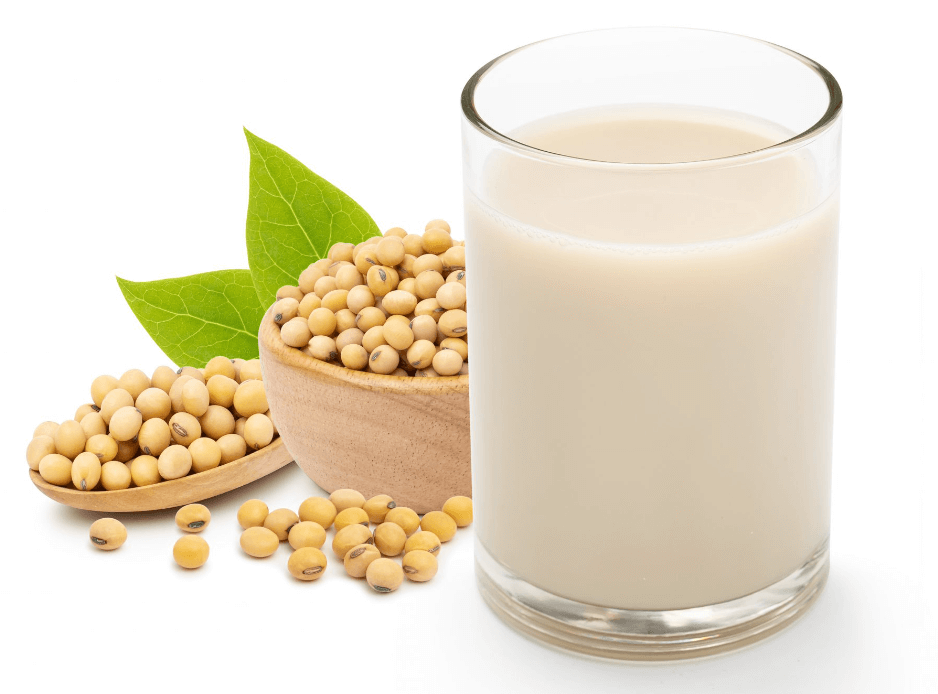
Here are some characteristics and potential benefits of soy milk:
The Food and Drug Administration (FDA) advises including [25 grams (g) of soy protein per day](https://www.accessdata.fda.gov/scripts/cdrh/cfdocs/cfcfr/cfrsearch.cfm?fr=101.82) in a diet low in saturated fat and cholesterol to mitigate the risk of heart disease.
Moreover, it is recommended to choose soy in its natural and minimally processed state, avoiding or minimizing the inclusion of added sugars, salts, and fats.
[Heart UK](https://www.heartuk.org.uk/healthy-living/cholesterol-lowering-foods) suggests incorporating 2–3 daily servings of soy-based foods or beverages, where one serving equals 250 milliliters (mL) of soy milk. Individuals can refer to the nutrition facts label on soy drinks to determine their soy protein content.
-
Soy milk can be used as a substitute for cow's milk in cooking and beverages, including coffee and smoothies.
-
Some soy milk products are fortified with calcium and vitamin D to compensate for potential deficiencies in a plant-based diet.
-
Soybeans contain phytochemicals like isoflavones, believed to have cardiovascular benefits.
-
Soy milk is naturally free of lactose, making it suitable for individuals with lactose intolerance or dairy allergies.
-
Soy milk is typically low in saturated fat, contributing to heart health.
-
Soy milk is a good plant-based protein source, making it a beneficial choice for vegetarians and those looking for alternatives to animal products.
-
Plant Protein Source:
-
Low in Saturated Fat:
-
Lactose-Free:
-
Rich in Plant Compounds:
-
Calcium and Vitamin D Enrichment:
-
Versatile for Cooking and Beverages:
Oat drinks
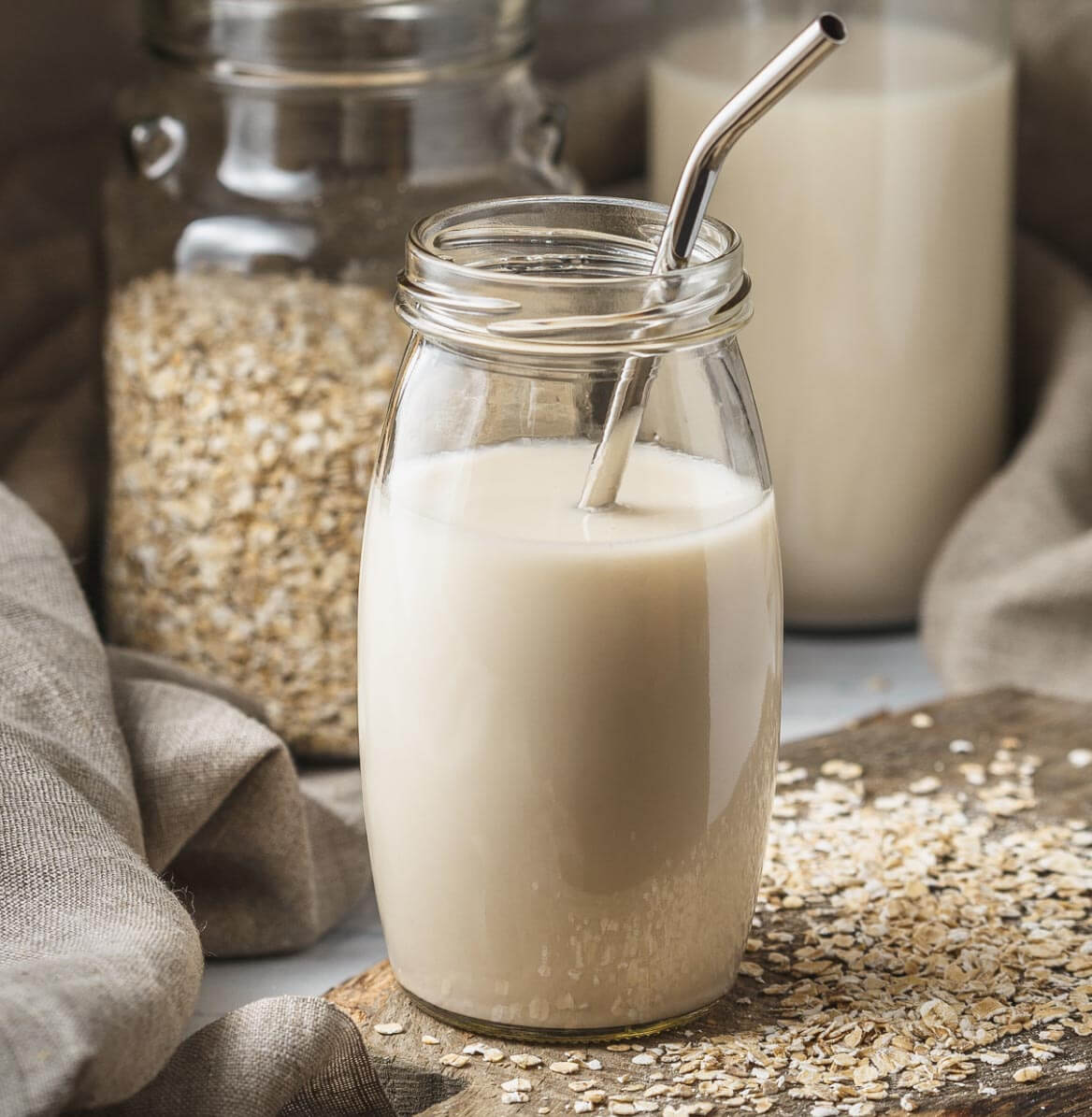 Benefits of Oat Drinks:
Oat drinks, made primarily from oats, offer several potential health benefits:
Benefits of Oat Drinks:
Oat drinks, made primarily from oats, offer several potential health benefits:
Oats contain beta-glucans, which form a gel-like substance in the digestive tract and interact with bile salts. These soluble fibers have the potential to [inhibit](https://www.ncbi.nlm.nih.gov/pmc/articles/PMC5810204/)
According to a [review from 2018](https://pubs.rsc.org/fi/content/articlehtml/2018/fo/c7fo02006f), oat drinks like oat milk may present a more uniform reduction in cholesterol compared to semi-solid or solid oat products. A 250 mL serving of oat milk may deliver 1 g of beta-glucans.
-
Oats cultivation and processing have a relatively lower environmental impact compared to some animal products, positioning oat drinks as an environmentally friendly choice.
-
Oat drinks often have a creamy texture, making them suitable as a breakfast beverage, coffee additive, or ingredient in cooking.
-
Due to their absence of dairy, oat drinks serve as a dietary alternative for vegetarians, vegans, and individuals allergic to dairy products.
-
Oat drinks may be rich in various nutrients such as vitamin D, B vitamins, minerals, and antioxidants.
-
Typically free of lactose and cholesterol, oat drinks are suitable for individuals with lactose intolerance and those monitoring cholesterol intake.
-
Oat drinks provide a moderate amount of plant-based protein, making them a beneficial choice for those seeking alternatives to animal products.
-
Oats contain beta-glucans, a soluble fiber associated with cholesterol reduction, contributing to cardiovascular health.
-
Oat drinks are rich in dietary fiber, promoting digestive system health by aiding in the slow digestion of food in the intestines.
-
Dietary Fiber Source:
-
Cardiovascular Health:
-
Plant-Based Protein:
-
Lactose and Cholesterol-Free:
-
Rich in Nutrients:
-
Dietary Alternative:
-
Palatable Texture:
-
Environmental Friendliness:
-
Tomato juice
**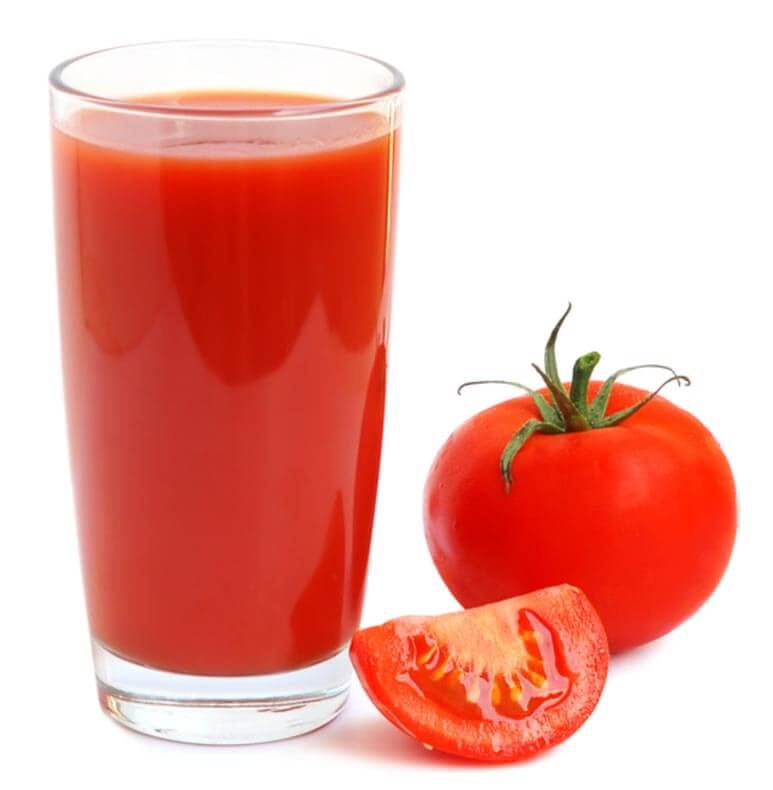
Benefits of Tomato Juice:**Tomato juice is a beverage made primarily from fresh or processed tomatoes, and it contains a variety of nutritional elements, including vitamins, minerals, and antioxidants, providing several potential health benefits. Here are some of the effects associated with tomato juice:
Studies indicate that the [lycopene content](https://www.degruyter.com/view/journals/chem/18/1/article-p752.xml) of tomatoes is enhanced through the process of turning them into juice. Furthermore, tomato juice is abundant in fiber that aids in reducing cholesterol levels and contains niacin.
In a [study conducted in 2019](https://www.ncbi.nlm.nih.gov/pmc/articles/PMC6657743/), it was discovered that the consumption of unsalted tomato juice led to an improvement in serum LDL cholesterol levels among 260 adults in Japan throughout the course of a year.
-
Unsweetened tomato juice is typically a low-calorie option compared to some other beverages, making it suitable for those mindful of their weight.
-
With its water content, tomato juice helps replenish the body's fluids, maintaining hydration levels.
-
Components in tomato juice are believed to have anti-inflammatory effects, aiding in relieving inflammation.
-
Some research indicates that lycopene, found in tomato juice, may be associated with a reduced risk of certain cancers, particularly prostate cancer.
-
Vitamins A and other antioxidants in tomato juice contribute to eye health, supporting overall vision.
-
The lycopene in tomato juice has been linked to cardiovascular health, and studies suggest it may help lower blood pressure and reduce cholesterol levels.
-
Tomato juice serves as a good source of vitamin C, vitamin A, potassium, and other minerals, essential for maintaining the immune system and supporting overall body functions.
-
Tomato juice is rich in antioxidants such as lycopene, vitamin C, and carotenoids, helping neutralize free radicals and slowing down oxidative processes.
-
Rich in Antioxidants:
-
Vitamin and Mineral Supply:
-
Cardiovascular Health:
-
Vision Support:
-
Reduced Cancer Risk:
-
Anti-Inflammatory Properties:
-
Hydration:
-
Low in Calories:
Berry smoothies
**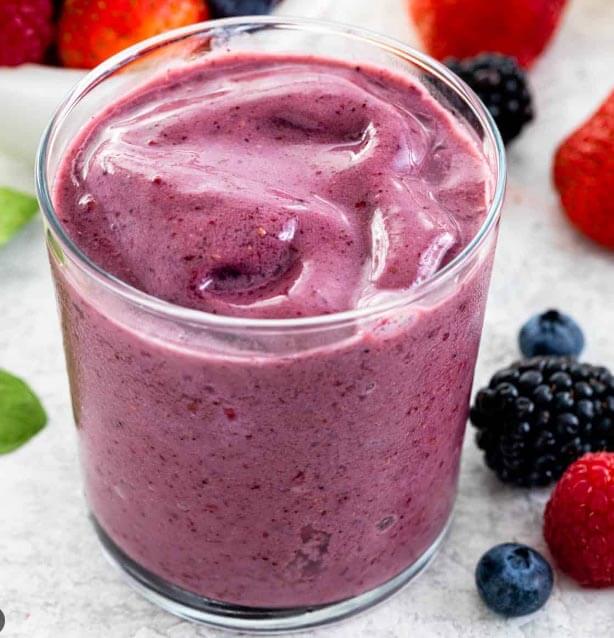
Benefits of Berry Smoothies:**Berry smoothies, made with fresh or frozen berries, offer numerous potential health benefits, including:
Especially, the robust antioxidant anthocyanins present in berries may contribute to [enhancing cholesterol levels.](https://www.ncbi.nlm.nih.gov/pmc/articles/PMC6770868/)
-
Berry smoothies, often containing a liquid base, help increase fluid intake, maintaining proper hydration.
-
Antioxidants in berries help protect the skin from free radical damage, contributing to maintaining healthy skin.
-
Berry smoothies, as nutritionally balanced low-calorie beverages, can be beneficial for weight control and providing long-lasting satiety.
-
Natural compounds in berries are believed to possess anti-inflammatory characteristics, assisting in alleviating inflammatory responses in the body.
-
Components in berries, such as anthocyanins and plant sterols, may contribute to cardiovascular health by potentially lowering blood pressure and improving lipid levels.
-
The dietary fiber in berries aids in maintaining digestive health, promoting normal bowel function, and helping control blood sugar levels.
-
Berries are rich in vitamins (e.g., vitamin C, vitamin K) and minerals (e.g., potassium, manganese), supporting the immune system, promoting bone health, and providing overall well-being.
-
Berries are natural sources of antioxidants such as vitamin C, flavonoids, and polyphenols, helping neutralize free radicals and slowing down cellular oxidation, contributing to the prevention of chronic diseases.
-
Antioxidant Power:
-
Vitamins and Minerals:
-
Dietary Fiber:
-
Cardiovascular Health:
-
Anti-Inflammatory Properties:
-
Weight Management:
-
Skin Benefits:
-
Hydration Boost:
-
Drinks containing sterols and stanols
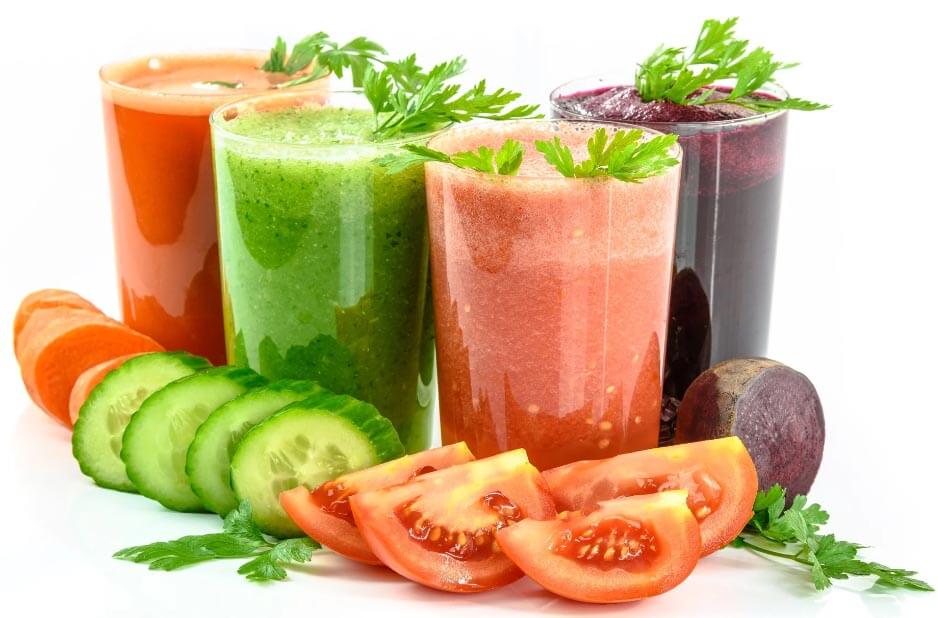 Benefits of Drinks Containing Sterols and Stanols:**Beverages containing sterols and stanols are primarily designed to provide these compounds, believed to have certain benefits for cardiovascular health. These effects include:
Benefits of Drinks Containing Sterols and Stanols:**Beverages containing sterols and stanols are primarily designed to provide these compounds, believed to have certain benefits for cardiovascular health. These effects include:
The [FDA](https://www.accessdata.fda.gov/scripts/cdrh/cfdocs/cfcfr/CFRSearch.cfm?fr=101.83) states that most people should try to consume 1.3 g or more of sterols and 3.4 g of stanols per day.
-
These types of beverages are typically considered as part of an overall heart-healthy plan and should be complemented by a balanced diet and lifestyle, including moderate exercise and dietary management.
-
While lowering LDL cholesterol, sterols and stanols do not affect high-density lipoprotein (HDL) cholesterol, maintaining a favorable HDL/LDL ratio.
-
By reducing LDL cholesterol levels, beverages containing sterols and stanols are believed to support cardiovascular health and lower the risk of cardiovascular diseases.
-
Sterols and stanols competitively inhibit the absorption of cholesterol in the intestines, reducing the body's uptake of cholesterol and consequently lowering LDL cholesterol levels.
-
Sterols and stanols, being natural compounds structurally similar to cholesterol, can help lower levels of low-density lipoprotein (LDL) cholesterol, contributing to maintaining a healthy cholesterol balance.
-
LDL Cholesterol Reduction:
-
Inhibiting Cholesterol Absorption:
-
Cardiovascular Health:
-
No Impact on High-Density Lipoprotein (HDL):
-
Complementing a Healthy Diet:
-
Cocoa drinks
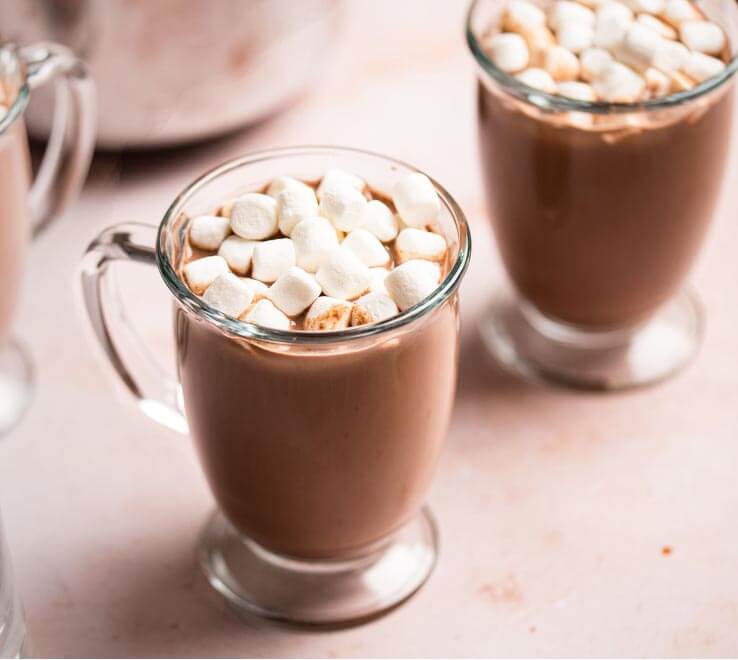 Benefits of Cocoa Drinks:**Cocoa drinks, made from cocoa beans, offer various potential health benefits. Here are some effects that cocoa drinks may have:
Benefits of Cocoa Drinks:**Cocoa drinks, made from cocoa beans, offer various potential health benefits. Here are some effects that cocoa drinks may have:
As per a [review in 2022](https://www.ncbi.nlm.nih.gov/pmc/articles/PMC9589144/), cocoa products have the potential to lower LDL and total cholesterol, although their impact on HDL cholesterol levels may not be significant.
-
Cocoa is a source of certain vitamins and minerals, including magnesium, iron, manganese, copper, and vitamin B, contributing to the maintenance of normal bodily functions.
-
Cocoa contains a small amount of caffeine, potentially providing a short-term energy boost and alertness.
-
Flavonoids in cocoa have been linked to improved cognitive function. Studies suggest that cocoa may positively impact aspects of brain function, particularly related to memory and learning.
-
Some components in cocoa, like theobromine, are believed to have mood-enhancing effects, potentially aiding in stress relief and uplifting mood.
-
Flavonoids in cocoa have been associated with cardiovascular health. Research suggests that cocoa may help lower blood pressure, improve vascular function, and reduce the risk of cardiovascular diseases.
-
Cocoa beans are rich in antioxidants such as flavonoids and catechins, helping neutralize free radicals and slowing down cellular oxidation, potentially preventing chronic diseases.
-
Antioxidant Properties:
-
Cardiovascular Health:
-
Mood Enhancement:
-
Cognitive Function Improvement:
-
Energy Boost:
-
Vitamins and Minerals:
-
Plant milk smoothies
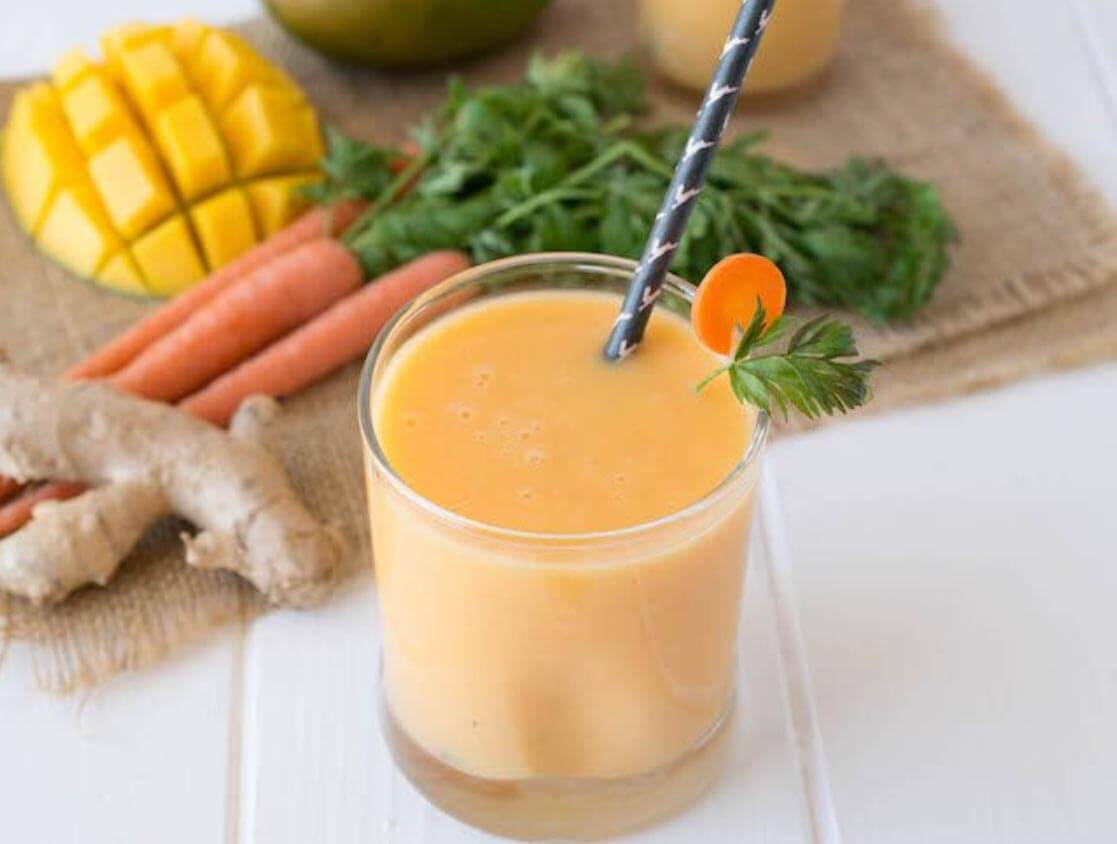 Benefits of Plant Milk Smoothies:**Smoothies made with plant milk, a delicious dairy-free alternative, typically use plant-based milk such as almond milk, coconut milk, soy milk, etc., as a base and are combined with fruits, nuts, seeds, and other ingredients. These smoothies may offer a range of potential health benefits, including:
Benefits of Plant Milk Smoothies:**Smoothies made with plant milk, a delicious dairy-free alternative, typically use plant-based milk such as almond milk, coconut milk, soy milk, etc., as a base and are combined with fruits, nuts, seeds, and other ingredients. These smoothies may offer a range of potential health benefits, including:
One can create a soy or oat smoothie by blending 250 mL of soy or oat milk with cholesterol-lowering fruits or vegetables, such as:
**Ingredients**
1 banana
1 handful of grapes or prunes
1 slice of mango or melon
2 small plums
1 cup of kale, baby spinach, or Swiss chard
2/3 cup pumpkin puree
-
Plant milk smoothies are suitable for individuals with milk protein allergies, providing an allergen-friendly alternative.
-
Compared to some animal-based dairy, plant milk usually contains lower levels of saturated fat, contributing to maintaining cardiovascular health.
-
Plant milk smoothies are an ideal choice for vegetarians and strict vegans, meeting their requirements for plant-based foods.
-
Plant milk is typically lactose-free, making it suitable for those intolerant to lactose or individuals choosing to avoid dairy.
-
Plant milk and added ingredients may contribute various natural minerals such as calcium, magnesium, manganese, potassium, crucial for bone health and normal bodily functions.
-
The addition of fruits and vegetables provides ample dietary fiber, promoting digestive health, sustaining satiety, and regulating blood sugar levels.
-
Ingredients like fruits and nuts added to the smoothie are usually rich in antioxidants, helping neutralize free radicals and slowing down cellular oxidation.
-
Plant milk often contains a moderate amount of plant-based protein, serving as a good protein source for vegetarians or those allergic to dairy.
-
Protein Source:
-
Rich in Antioxidants:
-
Dietary Fiber:
-
Natural Minerals:
-
Lactose-Free:
-
Suitable for Vegetarians and Vegans:
-
Low in Saturated Fat:
-
Allergen-Friendly:
Drinks to avoid
Individuals aiming to improve or maintain optimal cholesterol levels may wish to avoid the following:
- High Saturated Fat Foods:
- Limit the intake of foods high in saturated fats, such as red meat, processed meats, butter, and full-fat dairy, as these can contribute to elevated cholesterol levels.
- High-Cholesterol Foods:
- Reduce the consumption of high-cholesterol foods, including egg yolks, animal organs, and high-fat dairy products.
- Processed Foods:
- Minimize the consumption of processed foods, as they may contain hidden saturated fats, trans fats, and high salt content, negatively impacting cardiovascular health.
- High-Sugar Foods:
- Avoid excessive intake of high-sugar foods, as this may be associated with unfavorable cholesterol levels and cardiovascular health.
- Excessive Alcohol Consumption:
- Highly restrict or avoid excessive alcohol consumption, as alcohol intake is linked to adverse effects on cholesterol levels.
- Lack of Exercise:
- Maintain physical activity and avoid prolonged periods of inactivity, as moderate exercise can help elevate high-density lipoprotein (HDL) cholesterol levels, promoting cardiovascular health.
- Excessive Caffeine Intake:
- Control caffeine intake, as excessive caffeine consumption may have implications for cholesterol levels.
- Neglecting Dietary Fiber:
- Ensure the diet includes an adequate amount of fruits, vegetables, and whole grains rich in dietary fiber, as these foods contribute to regulating cholesterol levels.
These guidelines can assist individuals in maintaining a healthy diet and lifestyle focused on cholesterol levels.
Juices and Juicing Ingredients That Are Good for High Cholesterol
- Orange Juice:
- Rich in vitamin C and antioxidants, contributing to cardiovascular health.
- Grapefruit Juice:
- Contains plant compounds that may help lower cholesterol levels.
- Pomegranate Juice:
- Abundant in antioxidants, potentially aiding in cholesterol reduction and promoting cardiovascular health.
- Berry Juice:
- High in antioxidants, supporting vascular health.
- Grape Juice:
- Contains certain benefits akin to red wine, potentially positively impacting cardiovascular health.
- Watermelon Juice:
- Low in calories, high in water content, aiding in maintaining hydration.
- Green Apple Juice:
- Rich in flavor and natural sugars, a healthy sweet option.
- Beet Juice:
- Contains plant compounds that may contribute to cholesterol reduction.
- Carrot Juice:
- High in beta-carotene, beneficial for heart health.
- Tomato Juice:
- Contains lycopene, aiding in cholesterol level reduction.
- Swiss Chard Juice:
- Rich in nutrients, potentially beneficial for cardiovascular health.
- Kale Juice:
- Abundant in vitamins and minerals, potentially contributing to overall health.
- Spinach Juice:
- Rich in nutrients, potentially beneficial for the cardiovascular system.
- Broccoli Juice:
- High in fiber and antioxidants, positively impacting cardiovascular health.
- Pumpkin Juice:
- Contains beta-carotene, potentially aiding in cholesterol reduction.
- Ginger:
- Possesses anti-inflammatory and antioxidant properties, potentially beneficial for cardiovascular health.
- Cocoa:
- Contains theobromine, potentially contributing to cardiovascular health.
- Herbs:
- Some herbs have antioxidant and anti-inflammatory properties, beneficial for cardiovascular health.
conclusion
Juicing can be a valuable and enjoyable approach to promoting heart health and improving high cholesterol levels. Incorporating a variety of nutrient-rich fruits and vegetables into your juicing routine may contribute to positive cardiovascular outcomes. Here are key points to consider:
- Antioxidant-rich Ingredients:
- Juices made from fruits such as oranges, grapefruits, berries, and pomegranates are rich in antioxidants. These compounds help neutralize free radicals and support overall heart health.
- Plant Compounds for Cholesterol Reduction:
- Certain juices, like beet juice, may contain plant compounds that have been associated with cholesterol reduction. These compounds contribute to a heart-healthy juicing regimen.
- Heart-Healthy Nutrients:
- Juices crafted from vegetables like kale, spinach, broccoli, and herbs provide essential vitamins, minerals, and fiber that support cardiovascular well-being.
- Beta-carotene Sources:
- Carrot and pumpkin juices, rich in beta-carotene, contribute to the maintenance of optimal cholesterol levels and heart health.
- Lycopene from Tomato Juice:
- Tomato juice, containing lycopene, adds another dimension to cholesterol management by potentially reducing LDL cholesterol.
- Inclusion of Ginger and Cocoa:
- The incorporation of ginger and cocoa into juices introduces additional health benefits, such as anti-inflammatory properties and the potential to positively impact cholesterol levels.
- Hydration and Low-Calorie Options:
- Watermelon juice, with its low-calorie content and high water content, serves as a hydrating and heart-healthy option.
- Diverse Juice Combinations:
- Experimenting with diverse juice combinations, including green apple juice, can provide a variety of flavors while contributing to heart health.